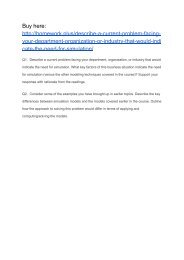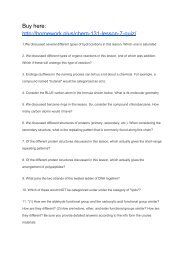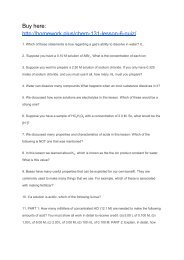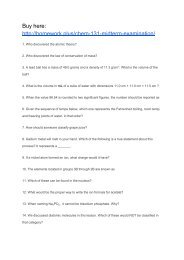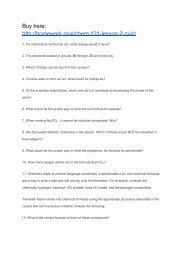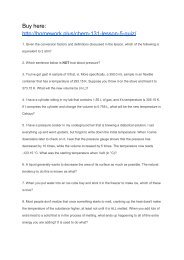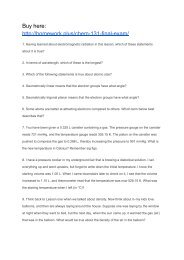CHEM 131 Lesson 4 Quiz
CHEM 131 Lesson 4 Quiz
CHEM 131 Lesson 4 Quiz
You also want an ePaper? Increase the reach of your titles
YUMPU automatically turns print PDFs into web optimized ePapers that Google loves.
Buy here:<br />
http://homework.plus/chem-<strong>131</strong>-lesson-4-quiz/<br />
1. Having learned about electromagnetic radiation in this lesson, which of these statements<br />
about it is true?<br />
2. In terms of wavelength, which of these is the longest?<br />
3. Which of the following statements is true about atomic size?<br />
4. Write out the electron configurations of the ions below and determine which one is listed with<br />
an incorrect charge. (the numbers and charges written after the elemental symbol should be<br />
understood as superscripts)<br />
5. If I time the movement of waves for 1 second, and calculate that 100 waves passed through in<br />
that 1 second, what have I calculated?<br />
6. Geometrically linear means that the electron groups have what angle?<br />
7. Geometrically trigonal planar means that the electron groups have what angle?<br />
8. Some atoms are better at attracting electrons compared to others. Which term below best<br />
describes that?<br />
9. According to the electronegativity table, the value for barium and sulfur is 0.9 and 3.5,<br />
respectively. What type of bond would you expect to form between these two elements?<br />
10. Regarding boron trifluoride, which of these is TRUE?<br />
11. On December 5, 1971, at the mere age of 35, the great composer Wolfgang Amadeus<br />
Mozart died after a three month long battle with illness. Rumor was that a rival musician had<br />
poisoned him, but it turned out that common consensus was that the antimony prescription that<br />
doctors had prescribed him was actually poisoning him.
(a) What is the full and abbreviated electron configuration for this element? Explain how you<br />
arrived at this configuration. In other words, don't just give me the configuration, but walk me<br />
through and explain to me how exactly you arrived at your answer.<br />
(b) In this <strong>Lesson</strong> we talked about the relationship between frequency and wavelength. The<br />
relationship can actually be expressed as<br />
where f is the frequency, c is the speed of light (see below), and lambda (the symbol on the left<br />
of the equals sign that looks like an upside down y) is wavelength. The particle nature of light<br />
was first proposed by Einstein, who suggested that light could be described as a stream of<br />
particles called photons. A photon of a certain wavelength (lambda) has an energy (E) given by<br />
the equation:<br />
where E is the energy of the photon in J, h is Planck's constant (6.626 x 10 -34 J*s), and c is the<br />
<br />
speed of light (3.00 x 10 8 m/s). If we determine the wavelength (lambda) of light emitted from a<br />
sample of antimony to be 206.8 nm, what is the energy (E) and frequency (f) that corresponds to<br />
this wavelength?<br />
12. Think about it--why is the line spectrum produced by excited barium atoms more complex<br />
than the line spectrum produced by excited sodium atoms? Be sure to base your answer on what<br />
we discussed in THIS class and use the terminology from the materials in THIS course. Your<br />
answer must be sufficiently detailed to receive credit






